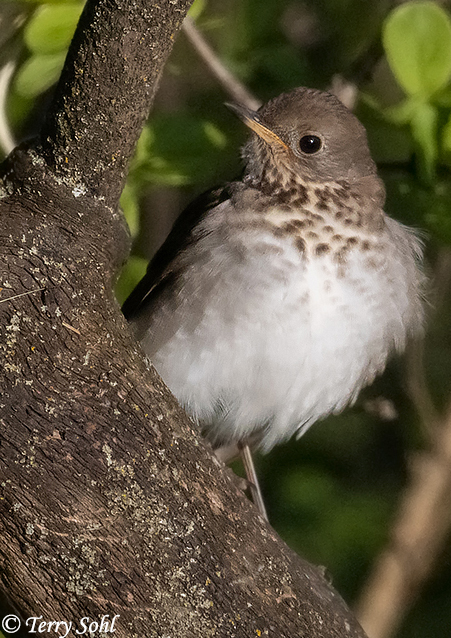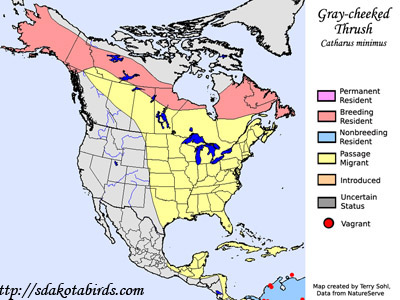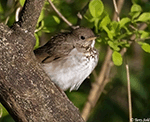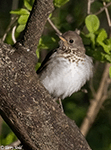| Length: 7 to 7.75 | Wingspan: 12 to 13 inches | Seasonality: Migrant |
| ID Keys: Grayish-brown upperparts, grayish-white underparts, spotted chest, indistinct grayish eye-ring, grayish neck and face. | ||
 The Gray-cheeked
Thrush breeds further north than it's similar close thrush relatives (Swainson's
Thrush, Veery, Hermit
Thrush), even utilizing thickets on the tundra for nesting. They are
extremely shy and difficult to approach, a habit that makes them doubly
difficult to view when combined with their preferred habitat of dense
forests. Some of the species migrate all the way from South America, to
Alaska, and then across the Bering Strait to Siberian nesting grounds.
The Gray-cheeked
Thrush breeds further north than it's similar close thrush relatives (Swainson's
Thrush, Veery, Hermit
Thrush), even utilizing thickets on the tundra for nesting. They are
extremely shy and difficult to approach, a habit that makes them doubly
difficult to view when combined with their preferred habitat of dense
forests. Some of the species migrate all the way from South America, to
Alaska, and then across the Bering Strait to Siberian nesting grounds.
Habitat:
Found in northern spruce forests during the summer breeding season. In the northern part of their range, they will utilize stunted spruce forests up to the treeline, and will use willow and alder thickets on the tundra. They are found in tropical forests during the winter.
Diet:
Insects and berries make up the majority of the diet. Will also feed on spiders and other small invertebrates.
Behavior:
Usually feeds by hopping along the ground in search of insects. They will also perch in trees and bushes as they feed on fruits and berries. Males often chase females through the forest in prelude to breeding.
Breeding:
Non-breeder in South Dakota. On their breeding grounds, the nest of a Gray-cheeked Thrush is a cup, placed in a small tree or shrub, typically within 12 feet of the ground. The nest is constructed of twigs, weed stems, strips of bark, and grasses, lined with fine grasses or moss. The female alone incubates the eggs, which hatch after about 13 days. The young fledge from the nest 10-14 days after hatching.
Song:
Thin whistling reminiscent of an oboe, with middle phrases that rise and first and last phrases that fall.
1Click here to hear the song of a Gray-cheeked Thrush.
2Click here to hear the call of a Gray-cheeked Thrush.
Migration:
Summers throughout northern Canada and Alaska, as well as in Siberia. Winters in South America. In South Dakota, Gray-cheeked Thrush are an uncommon spring migrant, and a rare fall migrant.
Interactive eBird map:
Click here to access an interactive eBird map of Gray-cheeked Thrush sightings
Similar Species:
Multiple thrush species with a similar structure and overall plumage migrate through the state. Species most likely to be confused with a Gray-cheeked Thrush are the following:
- Swainson's Thrush - Swainson's Thrush are more common than the Gray-cheeked Thrush (at least as a migrant in the eastern part of the state). They are buffier overall, with a warmer appearance to the plumage than the dull gray of a Gray-cheeked Thrush. Swainson's Thrush in particular have a buff lower cheek and a buffy wash across the chest. Swainson's Thrush also have an obvious eye ring, a feature lacking on the Gray-cheeked Thrush.
- Veery - Color is the primary means of differentiating a Veery from a Gray-cheeked Thrush. Veery have a rich, reddish brown coloring on their upperparts, more bright and colorful than any other thrush species on this page. They also have a warm buffy wash across the breast, compared to the duller gray tones on a Grey-cheeked Thrush.
- Hermit Thrush - Hermit Thrushes are also more richly colored than a Gray-cheeked Thrush, although the differences are mostly small. The exception, however, is the rump and tail, as Hermit Thrush have a distinctive, rich reddish-brown rump and tail that contrasts with the rest of the plumage on the bird's upperparts. Hermit Thrush also have a thin light eye ring that's lacking on a Gray-cheeked Thrush.
- Bicknell's Thrush - The most similar looking thrush species to a Gray-cheeked Thrush is the Bicknell's Thrush, a relatively rare species not found in South Dakota (only found as a breeding bird in select spots of New England and far southeastern Canada). In fact, the two were considered the same species until they were split in 1995. Extremely similar in appearance, the best way to differentiate between the two species is by voice, and by range.
Conservation Status:
There are indications that birds at the southern end of its breeding range are in decline, potentially due to climate change. They are a poorly researched species, however, and populations trends are unknown. They are, however, considered a species of "Least Concern" by the IUCN.
Further Information:
1) Boreal Songbird Initiative - Gray-cheeked Thrush
2) WhatBird - Gray-cheeked Thrush
3) Audubon Guide - Gray-cheeked Thrush
Photo Information:
May 10th, 2020 - Newton Hills State Park, South Dakota - Terry Sohl
Audio File Credits:
1Steve Hampton. Recorded near Nome, Alaska on June 3rd, 2017. Original recording and information from xeno-canto.
2Patrick Aberg. Recorded near Nome, Alaska on June 6th, 2017. Original recording and information from xeno-canto.
| Click on the map below for a higher-resoulution view |
 |
| South Dakota Status: Uncommon spring migrant, rare fall migrant. |
Additional Gray-cheeked Thrush Photos


